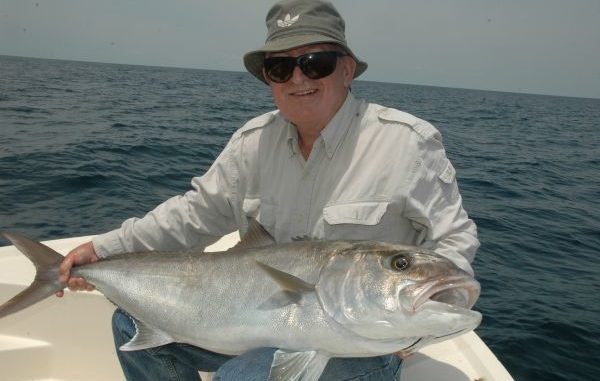
Super Strike Charters’ Capt. Damon McKnight shared some of the secrets he’s learned during his 25 years of battling amberjack out of his Venice headquarters.
Here are his thoughts:
Q: What do you like about amberjack fishing compared to other offshore species?
A: They are not very finicky most days and put up a great fight for customers. They also are very good to eat.
Q: How do amberjack fight compared to tuna?
A: An 80-pound tuna is a good fight to the end; that means a tuna will stay consistent throughout the fight.
An 80-pound amberjack puts up an unbelievable fight for the first five minutes — after that, they start to wear out.
It is critical to get the fish up quick or he will usually get you wrapped up in something and break you off.
But, for the first five minutes, that 80-pound AJ has a yellowfin tuna beat, for sure.
Q: In what area do you stop to catch hardtails for bait? Block number and depth of water? How many should you catch for bait? Can other baits be used?
A: We fish hardtails on any rig, rip, or buoy that might be holding them. It can be any block number, usually in 400 feet or less.
Fishing AJ’s with live bait can be quick some days, and it can take a while if there are other fish down there such as barracuda or sharks.
A good number to have is about 30 hardtails for amberjack. They should be on the larger size, about a pound or larger.
Other baits that you can use are jigs: Any type of diamond jig or metal jig will usually work if they are thick.
We have caught them trolling Stretch 30’s and Rapalas, as well.
Q: What is the best depth of water to fish for amberjack? Block numbers?
A: The best depth is around 300 feet. You can fish any rig in those depths in any block from Main Pass, South Pass, and West Delta.
Q: How deep should you go down with your bait? How can you tell?
A: Go down to 150 feet or better. You do not have to be exact on depth; however, you can mark your line in 20-foot increments by using a permanent marker or using colored tape.
Q: Is there a particular technique used to get them to bite (i.e. jigging up and down, etc.)?
A: No technique is really necessary for live bait. You just have to get it down to them.
For jigging it will take a fair amount of movement most days, but it has to be balanced. Most people barely bounce the jig, and do more reeling up and down than bouncing. So, there is some technique that has to apply in order to get the best bite.
Q: What general area do you fish/catch most of the amberjack?
A: We catch them in all of the West Delta, Main Pass, and South Pass blocks. We do better fishing in an area that has weaker current and clean water.
Amberjack schools do move from rig to rig, so you will usually have to do a little searching.
Q: What mistakes do most people make when fishing for amberjack?
A: The biggest mistake is not using heavy-enough tackle. The sure thing is to use the bigger stand-up equipment, with 250-pound test and big hooks.
They are a powerful fish, so you really have to work to get them away from structure.
Q: What are some other things that people should know about fishing for amberjack?
A: Be ready to lose a lot of tackle if you are not prepared. Do not show up with 80-pound PowerPro on a small rod and reel with a couple of jigs: You will surely lose most fish that you hook.
Go with the heavy tackle, and once you are hooked up have the captain or person behind the wheel pull away from the rig or reef to give you a better chance of getting the fish than losing him.
It will take some practice to get it figured out perfectly, but the key is to go heavy; they usually aren’t line shy.
Editor’s note: McKnight can be reached at can be reached at 800-318-1720 or www.superstrikescharters.com.
